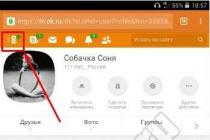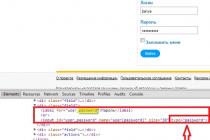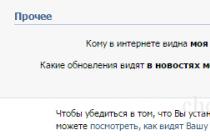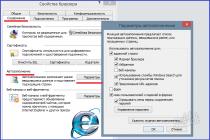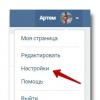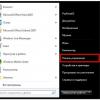Modem (Modulator-DEModulator) is a device for converting serial digital signals into analog and vice versa. Standards organizations use the common abbreviations DCE to refer to a modem and DTE to refer to a computer, terminal, or any other device connected to a modem. The modem has two interfaces (Fig. 2.31): the interface between the DCE and the analog line; multi-wire digital interface between DCE and DTE.
Point-to-point channel. The simplest network using modems is a point-to-point channel, in which two modems are connected (point-to-point) by one communication line (Fig. 2.32). A discrete channel connects DTE to DTE. The line connects DCE to DCE. A discrete channel consists of a line and two modems (DCE). Baud rates up to 20 kbps use a V.24 / V.28 (RS-232C) interface via a 25 or 9 pin female connector. For transmission rates of 48 kbps to 168 kbps, broadband modems with V.35 interface are required. At speeds up to 20 kbps, any of the following analog telephone lines can be used:
4-wire 2-point dedicated line; 4-wire multipoint leased line; 2-wire 2-point dedicated line; 2-wire 2-point dial-up line (communication by dialing through the PSTN); 4-wire 2-point dial-up line organized by switching two separate two-wire connections through the PSTN. The standards of telephone channels as derivatives of the standard PSTN channel of the voice frequency (FM) are presented in Table. 2.10.
Modes of operation of modems. Asynchronous. This mode is implemented by asynchronous modems, such modems are low-speed and operate in asynchronous start-stop mode. Asynchronous modems do not generate synchronization signals and can operate at any baud rate within their specified rate range. Synchronous. In this mode, data is transmitted in blocks, and the modem generates synchronization signals. Modems that implement only synchronous mode are called synchronous modems. Asynchronous-synchronous. This mode is implemented by asynchronous-synchronous modems, which can perform both synchronous and asynchronous transmission. The modem removes the start-stop bits before transmitting and restores them after receiving. Modems of this type generate synchronization signals and have a built-in asynchronous-synchronous converter. Asynchronous-synchronous and synchronous modems only work with fixed baud rates. When choosing a modem, the type of communication provided by the combination of the modem and the line is important.
Any modem operating with a 4-wire 2-point line uses one pair for transmitting and the other for receiving and therefore can operate in full duplex mode. Modems using a 4-wire multidrop line only operate in half duplex mode. Synchronous-only modems operate on a 4-wire, 2-point nonswitched line, or over the PSTN, with one dial-up connection providing half duplex and a double dial-up connection providing full duplex. Asynchronous-synchronous modems operate on 2-wire lines (either leased or dial-up), and they can all operate in full duplex mode. Modem compatibility. Data transmission over telephone networks is described by the recommendations of the series V of the International Telecommunication Union (Technical Standards Sector) - ITU-T. The compatibility check is to check the V series number indicated by the manufacturer in the specifications of the modem. The classification of the V series of recommendations is shown in Fig. 2.33.
 |
The modem can operate in two modes: command and data transmission. The command mode of the modem, as a rule, is set: when the power is turned on; during the initial initialization of the modem; after an unsuccessful attempt to connect to a remote modem; when interrupted from the keyboard by pressing the "hang up" key combination (most often); when exiting the data transfer mode via the ESCAPE sequence. In the command mode, the entire data stream entering the modem via the V.24 / V.28 interface is perceived by it as a command. The data transmission mode (on-line) is set after the modem sends the CONNECT message in the following cases: when a successful attempt to establish a connection with a remote modem; when the modem performs a self-test. In the data transmission mode, the data stream entering the modem from the DTE is translated with conversion to a line, and the data stream from the line is translated with the reverse conversion to the interface with the DTE. Functional modes of the modem. The modem is always in one of two functional modes (except for the periods when it switches from one mode to another): command (local) and asynchronous connection mode (ON LINE). The modem transition diagram is shown in Fig. 2.34. When the power is turned on, the modem initializes its parameters in accordance with the configuration recorded in the non-volatile memory, and goes into the asynchronous command mode. Only in this mode does the modem accept AT commands. On the Z-command, the modem restores its working configuration
 |
from non-volatile memory and returns to command mode, “^ -command restores the configuration according to the manufacturer's profile (default setting) and returns to command mode. The modem "picks up the phone" in the auto-answer mode: a) when an A-command is received; b) automatically when S1 = SO, when the counter of incoming calls (calls) becomes equal to the number set for the answer; c) when a dialing command is received, when the call line ends with R. Functions of exchange circuits 103, 104, 109 V.24. Consider the functions of the exchange circuits associated with the transmission and reception of data: 103 (2) TxD (transmitted data) to DCE; 104 (3) RxD (Received Data) to DTE; 109 (8) CD (Received Linear Signal Detector) to DTE. The input stream of serial data entering the modem through circuit 103 is converted by the modulator into a modulated analog signal for outputting it to the line (Fig. 2.35). At the other end of the line, the remote modem demodulator receives the modulated line signal and converts it to a serial data stream for output through the receive data circuit 104.
 |
When a modulated carrier frequency is detected by the demodulator, circuit 109 transitions from an OFF state to an ON state. This introduces a delay between the moment the carrier is detected and the moment the state of the communication circuit 109 changes, known as the “on” delay of the carrier sensing. There is also a carrier sensing “off” delay that occurs when the carrier is turned off at the other end of the line. The circuit 109 in the internal circuit of the modem is necessary to fix the data exchange circuit 104 (data is received only when the circuit 109 is on). The CD turn-on delay and latching of the receive circuitry provide protection against transient line noise spikes that simulate spurious signals in the receive circuit 104.
Any data transmission system (DTS) can be described through its three main components. These components are a transmitter (or a so-called "information source"), a data transmission channel, and a receiver (also called a "receiver" of information).
In two-way (duplex) transmission, a source and destination can be combined so that their equipment can transmit and receive data simultaneously.
In the simplest case, the SPD between points A and B consists of the following main seven parts:
- Data terminal equipment at point A;
- The interface (or interface) between the data terminal equipment and the data channel equipment;
- Data channel equipment at point A;
- The transmission channel between points A and B;
- Data channel equipment at point B;
- Interface (or interface) of the data channel equipment;
- Data terminal equipment at point B.
Data Terminal Equipment (DTE) a generic term used to describe a user terminal or part of it. OOD can be a source of information, its recipient, or both at the same time.
The DTE transmits and / or receives data using data link hardware (DCE) and transmission link hardware. The corresponding international term is DTE (Data Terminal Equipment). Often a personal computer, mainframe computer, terminal, or any other equipment capable of transmitting or receiving data can act as a DTE.
Data link hardware is also referred to as data transmission equipment (ADF). international term DCE (Data Communications Equipment).The function of DCE is to enable the transfer of information between two or more DTEs over a certain type of channel, such as a telephone. To do this, the DCE must provide a connection to the DTE on one side and to the transmission channel on the other. The DCE can be an analog modem if an analog channel is used, or, for example, a service device. channel / data (CSU / DSU - Channel Semis Unit / Data Service Unit), if a digital channel is used.
Analog and digital communication channels.
Link -a set of distribution medium and technical means of transmission between two channel interfaces.
Depending on the type of transmitted signals, two large classes of communication channels are distinguished, digital and analog.
A digital channel is a bit path with a digital (pulse) signal at the input and output of the channel.
A continuous signal is input to the analog channel, and a continuous signal is also taken from its output.
Signal parameters can be continuous or take only discrete values. Signals can contain information either at each moment of time (continuous in time, analog signals), or only at certain, discrete moments in time (digital, discrete, pulse signals).
Newly created SPDs are trying to build on the basis of digital channels, which have a number of advantages over analog ones.
Information, regardless of its specific content and form, is always transmitted from the source to the consumer. Information presented in a specific form is called message. To transfer messages from a source to a consumer, remote from each other, a communication system is required.
Communication system (exchange system) call a set of technical means and mathematical methods designed to organize the exchange of messages between points. A diagram of such a communication system between two points includes a transmitter NS, channel TO and receiver NS.
Transmitter - it is a complex of technical devices designed to convert a message from a certain source into a signal that can be transmitted over a given channel.
Link - a set of technical means and a physical medium intended for signal transmission.
The physical medium through which the signal propagates (for example, electromagnetic oscillations) is called line .
Receiver - a set of technical devices that convert the signal appearing at the channel output into a message.
Converting a message into a signal during transmission is reduced to coding and modulation operations, for which the transmitter has an encoder and a modulator. Accordingly, the receiver includes a demodulator and a decoder.
Channels are classified on various grounds.
Depending on the destination systems, which include channels, they are subdivided into telephone, television, telegraph, telemetry, telecommand, digital information transmission, etc .; on the communication lines used - for cable, radio relay, etc.; by the band of occupied frequencies - into tonal, supra-tonal, high-frequency, short-wave, light, etc.
Depending on the structures signal channels are subdivided into continuous, discrete and combined (continuous-discrete or discrete-continuous). In continuous communication channels, continuous signals are used to transmit messages, in discrete - discrete, and, finally, in combined - signals of both types.
Such a subdivision of communication channels and the previously introduced subdivision of signals into continuous and discrete leads to four possible types of organizing the transmission of messages from a source to a consumer:
- The information source generates a continuous signal delivered to the consumer in the form of a continuous function - a continuous communication channel.
- The information source generates a continuous signal delivered to the consumer in a discrete form - a continuous-discrete communication channel.
- The information source generates a discrete signal delivered to the consumer in the form of a continuous function - a discrete-continuous communication channel.
- The information source generates a discrete signal delivered to the consumer in discrete form - a discrete communication channel.
The classification of discrete and continuous channels is arbitrary, since often a discrete channel contains a continuous channel inside it, at the input and output of which there are continuous signals.
Theoretically, a discrete channel is determined by specifying an alphabet of code symbols at the input, an alphabet of code symbols at the output, the amount of information transmitted by the channel per unit of time, and the value of probabilistic characteristics.
Depending on the number of code characters in the alphabet (the number system used), the channel is called binary, if m = 2, ternary - T= 3, etc.
Sources and consumers of information can be combined with each other both through direct (non-switched) channels and through transit paths composed of several channels by switching them (CC - channel switching) or by staged transmission of messages through switching centers as the channels of a given direction (CC - message switching).
Channels connecting terminal devices (sources, consumers) and switching centers are called subscription(AK).
Analog channels are the most common because of their long history and ease of implementation. When transmitting data, there must be a device at the input of an analog channel that would convert the digital data coming from the DTE into analog signals sent to the channel. The receiver must contain a device that converts the back-received continuous signals into digital data. These devices are modems.
Similarly, when transmitting over digital channels, the data from the DTE has to be converted to the form adopted for this particular channel. This conversion is handled by digital modems.
Basic model communication systems
The theoretical basis of modern information networks is determined by the Basic Reference Model for Open Systems Interconnection (OSI) of the International Standards Organization (ISO). It is described by the ISO 7498 standard. The model is an international standard for data transmission.
The OSI Interworking Reference Model identifies seven layers that form the open systems interoperability domain.
The main idea behind this model is that each level has a specific role. Thanks to this, the general task of data transmission is split into separate specific tasks. The functions of the level, depending on its number, can be performed by software, hardware or software and hardware. As a rule, the implementation of the functions of the higher levels is of software nature, the functions of the channel and network levels can be performed both by software and hardware. The physical layer is usually performed in hardware.
Each level is defined by a group of standards that include two specifications: the protocol and the service provided for the higher level.
Under protocol means a set of rules and formats that determine the interaction of objects at the same level of the model.
Modems .
 The history of modems began in the 30s. It was then that the equipment appeared, allowing the transmission of human speech over long distances, officially called "tone telegraphy equipment" and only especially advanced specialists called "modem". Generally speaking, human speech is transmitted over telephone wires in the form of fluctuations in electrical voltage. In order for the quality to be impeccable, it is necessary to transmit vibrations with frequencies from 50 to 10,000 Hz. However, it is too expensive to provide transmission of such a wide range of frequencies, therefore it is limited to the frequency range that provides satisfactory speech intelligibility - from 300 to 3400 Hz.
The history of modems began in the 30s. It was then that the equipment appeared, allowing the transmission of human speech over long distances, officially called "tone telegraphy equipment" and only especially advanced specialists called "modem". Generally speaking, human speech is transmitted over telephone wires in the form of fluctuations in electrical voltage. In order for the quality to be impeccable, it is necessary to transmit vibrations with frequencies from 50 to 10,000 Hz. However, it is too expensive to provide transmission of such a wide range of frequencies, therefore it is limited to the frequency range that provides satisfactory speech intelligibility - from 300 to 3400 Hz.
The signal at the output of the telegraph apparatus has frequency fluctuations from 0 Hz (that is, direct current) to 200 Hz. It is clear that such a frequency range did not fall within the limits of the passband and therefore could not be transmitted through telephone equipment intended for long-distance communication, and it was unprofitable to create special lines for the telegraph.
Then a device was invented for connecting a telegraph to a telephone channel, which required adaptation to the bandwidth of the telephone line. At the output of the telegraph apparatus, the voltage can take two fixed values, corresponding to zero and one. If you first encode and then decode the signal using the same algorithm, you get a prototype of modern modems.
The creation of a device that transmitted an arbitrary frequency signal to the telephone channel for a voltage of negative polarity, and a signal of a different frequency for a voltage of positive polarity, made it possible to inscribe the signal into the range of the telephone channel. At the other end was a device that senses the frequency of the received signal and converts signals of different frequencies into signals of different polarities. The first of the processes is called modulation, and the second, the opposite of it, is demodulation. Since simultaneous communication in two directions is possible via the telephone channel, devices were installed at each end of the channel that carried out both modulation and demodulation. From the abbreviation of the words "modulation" and "demodulation" the word "modem" was formed.
The very first PC modem was a device made by Hayes Microcomputer Products, which released the Micromodem II in 1979 for the then popular Apple II personal computer. The modem cost $ 380 and worked at 110/300 bps. Prior to that, there were only specialized devices on the market that combined mainframes.
By the way, Hayes also released the first 300 bps Smartmodem in 1981, the command system of which became the industry standard and remains so to this day. The first "commercial" 2400 bps modems were presented by several companies in December 1981 at Comdex for $ 800-900. And then it was time for the U.S. Robotics. In 1985, the company launched its famous Courier series, significantly lowering the cost of 2400 bps modems. At the beginning of the next year, the first Courier HST modem with a transmission rate of 9600 bps appeared, and in 1988, the Courier Dual Standard modems, which supported the HST and v.32 communication protocols ($ 1600), and the Courier v.32 ($ 1500). Two years later, the Courier v. 32bis modem was released, in 1994 - the Sportster v. 34 with a transfer rate of 28.8 Kbps ($ 349), and in 1995 - the Courier v.Everything 33.6 Kbps. ...
The digital signals generated by the computer cannot be directly transmitted over the telephone network because it is designed to carry human speech - continuous audio-frequency signals.
The modem converts digital signals from a computer into alternating current at an audio frequency - a process called modulation , as well as the inverse transformation, which is called demodulation ... Hence the name of the device: modem - mo dulator / dem modulator.
Modulationthe process of changing one or more parameters of the output signal according to the law of the input signal.
In this case, the input signal is, as a rule, digital and is called modulating. The output signal is usually analog and is often referred to as a modulated signal.
Currently, modems are most widely used to transfer data between computers over the public switched telephone network (PSTN, GTSN - General Switched Telefone Network).
For communication, one modem calls the other by the phone number, and that one answers the call. Then the modems send signals to each other, agreeing on a suitable communication mode for both of them. The transmitting modem then starts sending modulated data at the agreed rate (bits per second) and format. The modem on the other end converts the received information into digital form and transmits it to its computer. After finishing the communication session, the modem is disconnected from the line.

Modem communication implementation diagram
Modems
can also be classified according to the protocols they implement.Protocol is a set of rules that control the information exchange of interacting devices.
All protocols that regulate certain aspects of the functioning of modems can be classified into two large groups: international and proprietary.
International protocols are developed under the auspices of the International Telecommunications Union (ITU-T) and are accepted as recommendations. All ITU-T modem recommendations refer to the V series. Proprietary protocols are developed by Individual Modem Companies to excel in the competition. Often, proprietary protocols become the de facto standard protocols and are adopted in part or in full as ITU-T recommendations, as happened with a number of Microcom's protocols. Such well-known companies as AT&T, Motorolla, U. S. Robotics, ZyXEL and others are most actively developing new protocols and standards.
Modem types
Currently, a huge number of all kinds of modems are produced, ranging from the simplest ones, providing a transmission speed of about 300 bps, to complex fax-modem cards, which allow you to send a fax or an audio letter from your computer to anywhere in the world.
Let's consider only the so-called hayes-compatible modems. These modems support the Hayes AT command set for modem control. Currently, such modems are widely used all over the world to communicate with personal computers via telephone lines.
In hardware, modems are made either as a separate board inserted into a slot on the motherboard of a computer, or in the form of a separate case with a power supply unit that is connected to the asynchronous serial port of the computer.
The first one is called internal modem, and the second - external .
Internal modems tend to be more susceptible to interference and less robust. In addition, they have a rather unpleasant property of "freezing" and you can bring them out of this state only with the RESET button of the computer. But they also have a big plus: they do not interfere with you, do not take up space on your desktop and, moreover, receive power from the computer bus. In addition, they have the ability to store any data when the computer's power is turned off (similar to the CMOS of a computer).
External modems it is more convenient because you can always determine by the modem status indicator lamps what it is doing at the moment. In addition, they are less susceptible to interference.
Modems can operate in synchronous and asynchronous modes. In addition, there are full duplex and half duplex modes. Their difference is that in half-duplex mode, transmission at a time goes only in one direction, while in full-duplex mode, transmission is carried out in both directions simultaneously.
Facsimile standards
According to the recommendations of the Sector for Standardization of the International Telecommunications Union (ITU-T - International Telecommunications Union - Telecommunications), depending on the type of modulation used, faxes of four groups are distinguished. The first group 1 facsimile standards were based on the analog method of transmitting information. A page of text by fax group 1 was transmitted in 6 minutes. Group 2 standards have improved this technology in the direction of increasing the transfer rate, resulting in a transfer time of one page was reduced to 3 minutes.
The radical difference between fax machines of group 3 from earlier ones lies in the all-digital method of transmission at speeds up to 14400 bps. As a result, using data compression, group 3 fax transmits a page in 30-60 seconds. If the communication quality deteriorates, group 3 faxes go into emergency mode, slowing down the transmission speed. According to the Group 3 standard, two levels of resolution are possible: standard, which provides 1728 horizontal dots and 100 dpi vertical; and a high, doubling the number of vertical dots, which gives a resolution of 200x200 dpi and halves the speed.
Fax machines of the first three groups are focused on the use of PSTN analog telephone channels.
Group 4 standard provides resolutions up to 400x400 dpi and higher speeds at lower resolutions. Group 4 faxes provide very high quality resolution. However, they need high-speed communication links that ISDN can provide, and cannot operate over PSTN links.
For an internal modem, first of all, you need to set the COM port number and IRq line that it will use. The overwhelming majority of internal modems are visible to the computer as an additional COM-port, with the exception of Soft-modems with fully software control, which may have an arbitrary interface.
When setting the port number, keep in mind that all modern motherboards have a built-in I / O controller that supports two serial ports, by default usually working as COM1 and COM2. In BIOS Setup, for each of these ports, there can also be an Auto mode, in which the port is enabled only if there are free standard addresses and IRq lines. For example, if Auto is set for the second system port and an internal modem configured as COM2 is installed in the board, the BIOS, depending on the type and version, can either transfer the second system port to COM4, or disable it altogether.
If two ports are configured for one IRq line (IRq sharing), then it is possible to work with only one of them at any given moment of time. When you try to activate both ports, none will be able to work, except when both ports are served by a specialized program that is able to figure out which port generates which interrupt. If you set two ports to the same address, both will be inoperative.
Internal modems with Plug & Play interface do not need special configuration; it may only be necessary to set the jumpers to the PnP mode, if the modem also allows direct configuration of the address and IRq.
On an external modem, it may be necessary to set operating modes with switches, if any.
You can check if the modem port is working properly using any terminal program (Telix, Terminate, Telemate - for DOS, or the standard Hyper Terminal (Communication Program) - for Windows 95). On entering the AT&F line, the modem must answer OK. You can also use the ATZ line, however, if the Q1 mode is set by default, the modem will not give an OK response to this line.
After making sure that the modem is working, you need to create a set of default parameters. To do this, enter the & Fn command with the required configuration number described in the manual for the modem; configuration with hardware (RTS / CTS) data flow control is extremely desirable.
If it is desirable to have some parameters different from the factory configuration, their required values are specified after the & Fn command. After setting all the parameters, the & W command is entered, which writes the formed set as the default set with number 0. Subsequently, each time the modem is turned on or after the Z command is executed, this set of parameters will be set.
In order for the programs to correctly display the speed of the established connection, it is necessary to set the modem output mode in the CONNECT line to the real speed instead of the modem-DTE speed. This is done using the Wn command; other commands (for example, Vn) may also be required, which should be found in the description. You can check the format of the CONNECT line on most modems with the & T1 command, which establishes a test connection of the Local Analog Loopback type.
What is an initialization string and why is it needed?
An initialization string is a sequence of commands that brings the modem to a known state. Typically, such a line begins with one of the & Fn commands, which sets the factory defaults, followed by the commands to set the desired modes.
If the terminal program supports several initialization lines that are sequentially output to the modem, it is convenient to start the sequence with the Z command. In this case, the most common settings for all applications of the modem on the given station are written to the active set of default parameters.
In the event that one set of parameters is sufficient for all applications of the modem, it will be most convenient to store it in NVRAM. The initialization line in this case is reduced to a single Z command.
How can you optimize the modem and control program settings?
In the general case, the optimal setting of the modem and the program is very complex and ambiguous, however, in most cases, several of the most typical points can be distinguished:
Connection reliability. All modern modems support hardware error correction, however, the factory settings allow connection without correction if the modems failed to select a common correction protocol during the connection. As a result, even with an accidental interference at this moment, a connection without correction can be established, which is fraught with the appearance of a large amount of garbage at the output of the modem along with the useful data and a significant decrease in the overall transmission speed. To avoid such situations, it is recommended to set the forced correction mode with the commands N2, N4, N6 (for most modems), & M5 (USR / 3COM), etc.
> - The efficiency of data compression. By default, all modern modems try to use the compression protocol. In the case of transferring unpacked data, this most often increases the overall exchange rate, however, in the case of transferring efficiently packed information (ZIP, ARJ, RAR archives, minimized distribution sets, CAB files, etc.), the V.42 compression algorithm most often It is idle, and the MNP5 algorithm tries to compress the stream anyway, causing it to increase due to overhead. Therefore, if this communication session is mainly focused on transferring unpacked data, it is better to enable compression, if large volumes of packed data prevail, and the modem only supports MNP5, it makes sense to disable compression.
DTE interface bandwidth. When establishing a connection, the modem can either set the same baud rate with the DTE as in the channel (floating speed), or always work with the DTE at a fixed speed. The latter case is called the mode of fixing the speed of the port (Port Locking, Baud Locking, etc.) and is the most convenient and effective. It is recommended to set the fixed port speed to the maximum at which the system and programs retain the ability to reliably receive data, or at least twice the maximum connection speed. As a result, the increase in transmission speed due to data compression will be compensated for by the increase in port speed, and the DTE interface will not be a modem path bottleneck.
On lines of low quality, depending on the interference spectrum, different modulation protocols can behave differently at close bit rates. For example, with a V.34 connection at a speed of 16800 bps, the exchange rate due to error correction may be lower than with a V.32bis connection at a speed of 14400 bps. In such cases, it makes sense to forcefully limit the possible protocols and speeds for specific communication sessions.
What is the difference between asynchronous and synchronous modes?
In asynchronous mode, data is transferred byte by byte, each byte is preceded by a start bit and terminated with one or two stop bits. Thus, the minimum transmission unit is a byte, and the start / stop bits between bytes ensure correct identification of the beginning and end of each byte. This mode is convenient from the point of view of reliability of signal extraction from the line; however, it requires packing / unpacking bit data into bytes, and also reduces the transmission rates in the channel due to excessive start and stop bits (by at least 25% - 2/8).
In synchronous mode, data is transferred bit by bit, without grouping into bytes. In this case, there is no bit grouping overhead and the transmission unit is a single bit. Nevertheless, in order for the receiver to be able to resynchronize in the event of a loss of a part of the stream, the bits are often formatted into packets of different lengths, provided with a header and checksum. The minimum information unit in this case is the package. Since the length of the packet significantly exceeds the length of its service part, the overhead is much less.
All error correction and data compression protocols establish synchronous packet transfer mode between modems. At the same time, the exchange between the modem and the DTE most often takes place in an asynchronous mode, which, together with the overhead costs for the packaging and processing of packets, generates a speed difference in the channel and with the DTE. To compensate for this difference, the modem has a buffer and also uses flow control methods.
Specialized devices (pager stations, industrial data collection systems, etc.) often use synchronous transmission between themselves and the modem, themselves forming packets and monitoring their correctness. In such cases, due to the inability of a regular computer port to work in synchronous mode, the interaction of the computer with such devices through a pair of modems may be impossible.
Why is the connection on the internal modem broken when I change the video mode?
This happens mainly when working with a number of video adapters based on S3 microcircuits. These microcircuits are used to control the accelerator ports with addresses, the lower part of which coincides with the standard COM4 addresses (2E8. .2EF). With a properly implemented PCI / ISA interface on the motherboard, calls to these addresses should only be sent to the PCI bus, however, some chipsets on motherboards are mistakenly sent to the ISA as well. If the internal modem is configured for COM4, this will cause communication failure data, disconnection or even inoperability of the modem before its re-initialization.
Why doesn't the modem recognize a busy signal?
The vast majority of modems are set to recognize telephone signals in the US / Canada standard. The busy signal in this standard represents more frequent and quieter beeps than are accepted in the Russian telephone system. As a result, if the modem decoder does not have a sufficient margin for the duration / intensity of signals, their correct identification occurs rarely or does not occur at all.
If the modem has the ability to adjust the sensitivity to station signals and the range of their parameters, you can try to find the appropriate values. Modems oriented to the Russian telephone network (IDC, Russian ZyXEL, Russian Courier) were initially set to the parameters of Russian signals.
For modems that do not have such adjustments, in the case when the difficulty in recognizing the "busy" signal is caused by its too loud level, you can try to attenuate the input signal by connecting in series with the line a resistor with a resistance of 50-500 Ohm, however, this most often has a negative effect on the quality of communication.
Why the modem can freeze, and how to deal with it?
Like any computer, the internal microcomputer of the modem can freeze for several reasons:
microprogram errors
non-standard input signals or data elements against which the modem is not protected
poor quality filtering of supply voltages
electrostatic discharges or strong magnetic fields
The most common causes of freeze are the first two. In particular, in most modern modems, protocols are implemented by the method of finite state machines, which assume a large number of states and rules for transition between them. With this approach, it is extremely difficult to check all possible transitions and exclude the appearance of "forbidden" states, which the modem can enter by mistake, as well as incorrect chains of such states. As a result, with a certain combination of input conditions (types of modems in a pair, communication protocols, types of transmitted data, etc.), one or both modems can get into forbidden states. Depending on the severity of the hang, the modem can be removed from it either by setting the internal timer (if there is one), or by removing the DTR signal, or by a complete hardware reset.
If the modem hangs regularly and there is no way to change it or at least the microprogram, you can take compromise measures:
Set to & D3 mode to reset when DTR signal drops. However, on most modems, the DTR signal, along with others, is analyzed by the modem's processor, and a hung processor often turns out to be unable to respond to its change. Ruggedized modems may have a special mode in which the DTR signal is directly connected to the hardware reset circuit.
Install a hardware reset circuit in the modem that generates a Reset signal pulse, which is automatically generated when the power is turned on. The reset signal can be formed from the fall of the DTR signal, or you can take a separate signal from some other port (COM or LPT). In the first case, only the modification of the modem itself will be required, since almost all programs are able to reset the DTR to break the connection. In the second case, it will be necessary to start a special program, which will issue a signal to the desired port, from which the hardware reset circuit will work.
For an external modem, you can make a short-term power off scheme that works on the same principles. The method is good in that it does not require intervention in the circuitry of the modem itself.
The variant with the formation of an internal reset signal has a limited application in the case of an internal modem. The fact is that the internal modem always contains a COM port controller, which is configured by most programs only at the beginning of work. Thus, if the reset signal is formed from a drop in DTR, then the port will also be brought to the standard state, and the program will not be able to work with it until it is re-initialized. In this case, it is necessary that the program, upon detecting a hangup of the modem, abruptly restarts.
What is the maximum CPS achievable at a given bit rate?
Provided that there are no bottlenecks in the traffic (in particular, the speed of asynchronous serial ports on both sides exceeds the speed of the connection) and data is transferred everywhere at the maximum speed, the maximum CPS without effective compression (for example, when transmitting 90.95 archives) is, for example, approximately 90.95. % of bit rate divided by eight. For example, for a speed of 14400 bps the CPS limit is about 1650, and for 28800 - about 3400. With the efficient operation of the compression protocols, the real speed can increase two or more times (long series of repeated characters are most effectively compressed).
Various programs measure CPS in different ways during exchange: some display only the instantaneous value calculated during the transmission of the current packet, others - the result of dividing the total number of transmitted / received bytes by the time from the beginning of the exchange. In the first case, the value varies greatly from the influence of short-term factors, and in the second, it is unjustifiably underestimated. The most correct is the display of the average CPS for a short period of time (several seconds) with a simultaneous calculation of the average CPS for the entire transmission time.
What is the difference between dial-up and leased lines?
The standard switched line is distinguished by the presence of a supply voltage (about 60 volts in Russian telephone networks) and the ability to send and receive line status and dialing signals. Accordingly, when working on a dial-up line, the calling modem generally waits for an uninterrupted dial tone, then dials a number, and only after that waits for a response from the remote modem. The answering modem, in turn, receives the call signal (ringing), then connects to the line ("picks up the handset") and goes into answer mode.
> - A dedicated line is a permanent point-to-point connection between two subscribers. Typically this is a two- or four-wire communication line, directly connecting two modems and not connected in any way to the station equipment. In the simplest case, it can be an ordinary telephone cable included in the modem's kit, in the most complex section of a multichannel wire, fiber-optic or radio channel, which, with the help of channel equipment, simulates a simple wire connection.
Modems that support leased line operation (& L1 command) in this mode automatically disable the continuous dial tone check, and also automatically try to restore the connection if it is broken. For the initial connection setup, one modem must be activated as the caller (command D) and the other as the answer (command A). After that, the restoration of communication in the event of a break is performed by the modems themselves in the same roles.
> - In addition, modems supporting leased lines have memorized modes in which the establishment of communication in the selected role is performed automatically when the power is turned on (or after the appearance of the DTR signal). Thus, a pair of such modems immediately after turning on the power or the appearance of DTR creates an automatically maintained connection without the intervention of control programs, which in this case remains only monitoring the DCD signal and / or the CONNECT / NO CARRIER messages. Ideally, such a pair of modems allows you to organize a completely transparent connection, similar to a null-modem cable, in which the programs are completely unaware of the existence of any additional devices in the contract.
Almost all modems can work on a dedicated line - even those that do not support the & L1 command. It is enough that the modem does not pay attention to the presence of voltage in the line (some modems have a voltage sensor) and does not try to wait for a dial tone when switching to the call mode (this is provided by the X3 command). To establish a connection, X3D commands are entered on the calling modem, after which the A command is entered on the responder. The only inconvenience in this case is that ordinary modems cannot automatically restore a broken connection.
The described technology can also be used when working on a dial-up line - to establish modem communication over a channel already connected for a voice conversation. In this case, the modems must be connected in parallel to each telephone set, their operators choose the roles of the caller / answer, after which the caller enters the D command and, after connecting his modem to the line, puts the pipe down. The responding operator, having heard the click of the remote modem connected to the line, enters the A command and also puts down the handset, after which the B Apere modems start exchanging connection set-up signals.
How to connect a modem through a blocker or AVU?
The blocker is used to separate paired subscriber lines when two subscriber lines are connected to one telephone pair, each of which uses its own polarity of supply and ringing voltage, and simultaneous operation of both lines is impossible. A typical blocker is a diode unipolar rectifier that allows only the voltage of "its" polarity into the subscriber line, and also contains a transistor switch that closes the reverse current of the ringing signal (bell). Such a blocker is designed for telephones with inductive ringing; after the completion of the next half-period of the unipolar ringing signal, a current of the same direction appears in the bell coil, which closes through the transistor switch. Telephone sets with electronic ringing and modems contain a decoupling capacitor, in which a current of opposite direction is generated, and for this there is no discharge circuit in the blocker. As a result, the device or modem works normally in all modes, except for call recognition.
For normal operation on paired lines, blockers are produced that support devices with an electronic call. You can also independently assemble a circuit that ensures the return current closure and the discharge of the decoupling capacitor.
With the help of AVU (high-frequency multiplexing equipment), several (usually two) subscriber lines can be connected to a two-wire telephone line, which can work simultaneously. At the same time, one of the lines works in the usual mode - at a low frequency, and the rest - at high frequencies. To transmit call signals over the line compressed by the AVU, special signals are used, received by the AVU unit and converted into a standard ringing signal with a voltage of 110 V and a frequency of 100 Hz. A typical AVU unit is also designed for devices with an inductive bell and has three connection points: two - a low-voltage line, and the third - a ring signal output. To connect devices with an electronic call or modems, you need either an AVU unit with two connection points, or a special adapter.
If, through the blocker, the modem generally works with virtually no loss of quality, then through the high-frequency line of the AVU, speeds of no higher than 9600 are usually available.
> - What is FOSSIL?
Fido / Opus / SeaDog Standard Interface Layer is a standard interface layer jointly developed by Fido, Opus and SeaDog. Serves to unify the interface with serial ports in DOS, replacing and supplementing the BIOS functions. In addition to the standard BIOS character wait I / O functions, it provides non-wait I / O functions, interrupt operation, buffered I / O, and so on. FOSSIL can also include a video adapter interface. The most famous DOS versions of FOSSIL are BNU and X00.
FOSSIL is useful under multi-tasking systems like OS / 2 and Windows. Standard means of virtualization of ports of these systems emulate only the behavior of a port at the hardware level - byte I / O on interrupts, while emulation of byte exchange with interruption for every few bytes creates noticeable byte overheads and leads to periodic bytes. Versions of FOSSIL for these systems provide DOS programs with an optimal interface with ports. The most famous version of FOSSIL for Windows is WinFossil, for OS / 2 - SIO (Serial I / O). SIO is a development of the X00 version and, in addition to supporting FOSSIL functions, emulates the connection of two serial ports using network protocols.
Where can I get drivers for Win95 / 98 for a modem ...?
For most modems, as well as for monitors, there are no special drivers - Windows uses standard serial port drivers. The exception is modems with non-standard interface - Soft-modems, modems with RPI, some voice modems.
Nevertheless, to correctly identify the modem in Windows, an INF file is required that contains the modem's characteristics, mode setting commands, message strings, etc. For most modems, these files are included in the package.
If Windows is not able to recognize the modem even if there is an INF file from the manufacturer, this means that either the full name of the modem type in the INF file does not match the one issued by the modem itself using the In commands, or the INF file is intended for another version of Windows. If you cannot find the correct INF file on the manufacturer's website or BBS, you can try to set the type of standard modem that is suitable for speed. This will not affect the quality of communication - only advanced features (voice, fax, AOH, etc.) will not be supported.
How to reduce the noise from the dialing relay?
The minimum solution: to glue the relay with pieces of foam, choosing their size and configuration for optimal sound absorption. This method, however, rarely gives a noticeable effect, since the vibration of the relay is transmitted to the entire board, which radiates more strongly than the relay case itself.
Optimal solution: evaporate the relay and connect it with segments of a thin flexible wire, and glue the relay itself with foam. In this case, the vibration will practically not be transmitted to the printed circuit board.
The fundamental solution is to replace the relay with a Hercon relay. 5-volt RES-55A (model 0201) are well suited. If the relay has two pairs of contacts, the second of which turns off the parallel telephone, you can put two relays, or close the telephone switch shortly. The relay can also be replaced with an electronic key, which are sold on radio markets, however, in this case, the signal-to-noise ratio may deteriorate due to the parasitic influence of the electronic components of the key.
2. Classification of modems. Comparative analysis of different classes. Evaluation of characteristics.
2.1 Classification of modems
At first glance, there is nothing easier than classifying modems. It goes without saying that they are divided into external and internal. Of course, someone may suggest to divide them by speed (14400 bps, 28800 bps, 33600 bps, 56K), and, last of all, remember about the possibility of data transfer in synchronous and asynchronous modes. However, this is a very five-eye view from a height. This is far from being the case up close.
Let's try to classify the devices entrusted to us in more detail.
And so, let's start with the fact that distinguish between modems designed to work only on dedicated or only dial-up lines, as well as on both. Distinguish between modems for digital and analog lines.
Depending on the supported data transfer mode, modems are divided into:
supporting only asynchronous operation;
supporting asynchronous and synchronous modes of operation;
supporting only synchronous operation.
By design (this characteristic determines the appearance, size and location of the modem in relation to the computer):
internal modem - plugs into the computer like an expansion card. They, in addition, are divided into controller and non-controller. The former includes most of the existing internal modems designed for the ISA interface. The second is for PCI interfaces. Further development of PCI-modems are SOFT-modems (otherwise Win-modems).
desktop modem - has a separate case and is placed next to the computer, connected with a cable to the computer port. Sometimes it is called an external modem, which is not entirely correct, tk. the next two types are also external (i.e. located outside the computer system unit).
a modem in the form of a card is miniature and is connected to a laptop through a special connector (those who have seen a network card for a laptop will understand what is at stake).
portable modem - similar to a desktop modem, but has a reduced size and autonomous power supply.
rack modems - are inserted into a special modem rack, which increases the usability when the number of modems exceeds a dozen.
By the nature of their application, modems can be divided into ordinary and professional ones.
By conventional modems we mean devices commonly used by the end user at home or in the office. These modems only use telephone lines.
Professional modems are the most advanced and high-speed devices, mostly rack-mountable. They are used for the integration of local networks, in modem pools, as well as for remote access to LAN resources.
Among ordinary modems, there are 3 types:
devices for data exchange (just modems);
devices for data and document exchange (fax modems);
devices for exchanging data, documents and receiving voice messages (voice fax modems).
It should be noted that usually data transmission and telephone conversation cannot be carried out simultaneously. The exception is the SVD modem and RadishVoiceView technology, which are designed for simultaneous voice and data transmission.
Support for facsimile mode is not excluded in professional modems, but they usually do not provide sound support.
Let us choose the transmission medium as the next classification feature. By the type of transmission medium, one can distinguish:
modems for 2-wire copper lines (regular, professional, ADSL, SR, ER-modems);
modems for 4-wire copper lines (regular, professional, HDSL, ISDN, SR, ER, MR-modems);
modems for fiber optic lines (FOM, FOM-T1 / E1, FOM-T2 / E2, FOM-T3 / E3);
2.2 Comparison of characteristics of modems for dedicated and switched channels
2.2.1 Modems for dedicated channels
A dedicated channel is a channel with a fixed bandwidth or a fixed bandwidth that constantly connects two subscribers. Subscribers can be both individual devices (computers or terminals) and entire networks.
Dedicated lines are usually leased from companies operating on a local area network, although large corporations can run their own leased lines.
Dedicated channels are divided into analog and digital, depending on what type of switching equipment is used for permanent switching of subscribers. On analog dedicated lines for data transmission equipment, the physical and channel protocols are not rigidly defined. The absence of a physical protocol leads to the fact that the bandwidth of analog channels depends on the bandwidth of the modems that the user of the channel uses. The modem actually sets the required physical layer protocol for the channel.
On digital leased lines, the physical layer protocol is fixed - it is specified by the G.703 standard.
Modems for working on dedicated analog channels
For data transmission over dedicated analog lines, modems are used that work on the basis of methods of analog signal modulation. Modem protocols and standards are defined in the CCITT V-series guidelines. These standards define the operation of modems for both leased and dial-up lines.
As already mentioned in clause 2.1, modems can be synchronous, asynchronous and synchronous-asynchronous.
Asynchronous-only modems typically support low data rates of up to 1200 bps. So, modems operating according to the V.23 standard can provide a speed of 1200 bps on a 4-wire leased line in full-duplex asynchronous mode, and according to the V.21 standard - at a speed of 300 bps over a 2-wire leased line also in duplex asynchronous mode. Duplex mode on the 2-wire termination is provided by frequency division multiplexing. Asynchronous modems are the cheapest form of modems, as they do not require high-precision clock synchronization circuits on crystal oscillators. In addition, the asynchronous mode of operation is unpretentious in terms of line quality.
Synchronous-only modems can only be connected to a 4-wire termination. Synchronous modems use highly accurate timing circuits to extract the signal and are therefore usually significantly more expensive than asynchronous modems. In addition, the synchronous operation places high demands on the quality of the line.
For a dedicated voice channel with 4-wire termination, quite a few V-series standards have been developed. All of them support duplex mode:
V.26 - baud rate 2400 bps;
V.27 - transmission rate 4800 bps;
V.29 - baud rate 9600 bps;
V.32 ter baud rate 19,200 bps.
There are three standards for dedicated broadband 60-108 kHz cocoa:
V.35 - transmission rate 48 Kbps;
V.36 - transmission speed 48-72 Kbps;
V.37 - baud rate 96-168. Kbps.
Synchronous error correction is typically done using HDLC, but IBM's legacy SDLC and BSC protocols are acceptable. Modems of the V.35, V.36 and V.37 standards use the V.35 interface for communication with the DTE.
Asynchronous and synchronous modems are the most versatile devices. Most often, they can operate both on dedicated and switched channels, providing full-duplex operation. On dedicated channels, they support mostly 2-wire termination and much less often 4-wire termination.
A number of V-series standards have been developed for asynchronous-synchronous modems:
V.22 - transmission rate up to 1200 bps;
V.22 bis - transmission rate up to 2400 bps;
V.26 ter - transmission rate up to 2400 bit / s;
V.32 - transmission rate up to 9600 bps;
V.32 bis - transmission rate 14 400 bit / s;
V.34 - transfer rate up to 28.8 Kbps;
V.34 + - bit rate up to 33.6 Kbps.
The V.34 standard, adopted in the summer of 1994, marks a new approach to data transmission over the voice channel. This standard has been developed by CCITT for a long time - since 1990. A great contribution to its development was made by Motorola, which is one of the recognized leaders in this industry. The V.34 standard was developed to transmit information over channels of almost any quality. A feature of the standard is the procedures for dynamic adaptation to changes in channel characteristics during information exchange. Adaptation is carried out during a communication session - without termination and without interruption of the established connection.
The main difference between V.34 and previous standards is that it defines 10 procedures by which the modem, after testing the line, selects its main parameters: carrier and bandwidth (the choice is made from 11 combinations), transmitter filters, optimal transmission level and others. ... The initial connection of the modems is V.21 at a minimum speed of 300 bps, which allows operation on the poorest lines. QAM redundant codes are used to encode the data. The use of adaptive procedures immediately made it possible to increase the data transfer rate by more than 2 times in comparison with the previous standard - V.32 bis.
The principles of adaptive line tuning have been developed in the V.34 + standard, which is an improvement over the V.34 standard. The V.34 + standard has slightly increased the data transfer rate by improving the coding method. In the new standard, one transmitted code symbol carries on average not 8.4 bits, as in the V.34 protocol, but 9.8. With a maximum code symbol rate of 3429 baud (this limitation cannot be overcome, as it is determined by the bandwidth of the tone channel), the improved coding method gives a data rate of 33.6 kbps (3429 x 9.8 - 33604). However, experts note that even in America, only 30% of telephone lines will be able to provide such a low level of interference that V.34 + modems can operate at maximum speed. Nevertheless, V.34 + modems have advantages over V.34 modems even on noisy lines - they keep the connection better than V.34 modems.
The V.34 and V.34 + protocols allow you to operate on a 2-wire leased line in full duplex mode. The duplex transmission mode in the V.32, V.34, V.34 + standards is provided not by means of frequency division of the channel, but by means of simultaneous data transmission in both directions. The received signal is determined by DSPs subtracting the transmitted signal from the total signal on the channel. For this operation, echo cancellation procedures are also used, since the transmitted signal, reflected from the near and far ends of the channel, distorts the overall signal (the data transmission method described in the draft 802.3ab standard, which defines the operation of the Gigabit Ethernet technology on twisted pair of category 5 , took a lot of V.32-V.34 + standards).
At high speed, V.32-V.34 + modems virtually always use synchronous mode on the link. At the same time, they can work with DTE both via an asynchronous interface and a synchronous one. In the first case, the modem converts the asynchronous data to synchronous data.
Modems for working on dedicated digital channels
Digital leased lines are formed by permanent switching in primary networks, built on the basis of switching equipment operating on the principles of channel division in time - TDM, described in Chapter 2. There are two generations of digital primary network technologies - pleiochronous technology (“plesio” means “ almost ", that is, almost synchronous) digital hierarchy (Plesiochronic Digital Hierarchy, PDH) and more recent technology - synchronous digital hierarchy (Synchronous Digital Hierarchy, SDH). In America, SDH conforms to the SONET standard.
Digital multiplexing and switching equipment was developed in the late 60s by AT&T to solve the problem of connecting large telephone switches to each other. Frequency division multiplexed channels, previously used at ATS-ATS sections, have exhausted their capabilities in organizing high-speed multichannel communication over a single cable. In FDM technology, twisted pair was used to transmit 12 or 60 subscriber channels simultaneously, and to increase the communication speed, it was necessary to lay cables with a large number of pairs of wires or more expensive coaxial cables. In addition, the frequency division multiplexing method is highly sensitive to various kinds of interference that are always present in territorial cables, and the high-frequency speech carrier itself creates interference in the receiving equipment, being poorly filtered.
To solve this problem, the T1 equipment was developed, which made it possible to digitally multiplex, transmit and commute (on an ongoing basis) the data of 24 subscribers. Since the subscribers still used conventional telephones, that is, voice transmission was in analog form, the T1 multiplexers themselves digitized the voice at a frequency of 8000 Hz and encoded the voice using Pulse Code Modulation (PCM). As a result, each subscriber channel formed a 64 Kbit / s digital data stream. T1 channels were too weak means of multiplexing to connect backbone automatic telephone exchanges, therefore the idea of forming channels with a hierarchy of rates was implemented in the technology. Four T1 channels are combined into a channel of the next level of the digital hierarchy - T2, transmitting data at a rate of 6.312 Mbit / s, and seven T2 channels, when combined, give a T3 channel, transmitting data at a rate of 44.736 Mbit / s. Equipment T1, T2 and T3 can interact with each other, forming a hierarchical network with backbone and peripheral channels of three levels of speed.
Since the mid-70s, leased lines built on T1 equipment began to be leased by telephone companies on commercial terms, ceasing to be the internal technology of these companies. T1 networks, as well as faster T2 and T3 networks, allow transmitting not only voice, but also any data presented in digital form - computer data, television images, faxes, etc.
The digital hierarchy technology was later standardized by CCITT. At the same time, some changes were made to it, which led to the incompatibility of the American and international versions of digital networks. The American version is distributed today in addition to the United States also in Canada and Japan (with some differences), and in Europe the international standard is applied. Analogs of T channels in the international standard are inals like E1, E2 and EZ with other speeds - respectively 2.048 Mbit / s, 8.488 Mbit / s and 34.368 Mbit / s. The American version of the technology has also been standardized by ANSI.
The physical layer of PDH technology supports various types of cables: twisted pair, coaxial cable, and fiber optic cable. The main option for subscriber access to T1 / E1 channels is a cable of two twisted pairs with RJ-48 connectors. Two pairs are required for full duplex data transfer at a speed of 1.544 / 2.048 Mbps. To represent the signals, the following is used: in the T1 channels the bipolar potential code B8ZS, in the El channels the bipolar potential code HDB3. To amplify the signal on T1 lines, regenerators and line monitoring equipment are installed every 1800 m (one mile).
Coaxial cable, due to its wide bandwidth, supports a T2 / E2 channel or 4 T1 / E1 channels. For the operation of T3 / E3 channels, either coaxial cable, or fiber-optic cable, or microwave channels are usually used.
Thus, modems intended for operation in digital leased lines belong to the following classes:
modems for 4-wire copper lines;
modems for fiber optic lines;
modems for radio channels (radio modem, cellular modem);
cable modems (use coaxial cable).
They will be discussed in more detail below.
Information about the work “Modems: use in networks, differences in architecture, comparative characteristics, features of operation. Abnormal situations and their resolution. Diagnostics and testing "
With the use of printing computer technology? 10. Describe the criminal acts provided for by Chapter 28 of the Criminal Code of the Russian Federation "Crimes in the field of computer information." SECTION 2. FIGHT AGAINST CRIMES IN THE SPHERE OF COMPUTER INFORMATION CHAPTER 5. CONTROL OF CRIME IN THE SPHERE OF HIGH TECHNOLOGIES 5.1 Control over computer crime in Russia Measures to control ...




Application software reactions. - Identification of defects in application software, which result in inefficient use of server and network bandwidth. We will dwell in more detail on the first four stages of complex diagnostics of a local network, namely, on diagnostics of the link layer of a network, since the diagnostic problem is most easily solved for a cable system. As already discussed in ...
Events at a new place of work, residence; also surrounded by bearers of trade secrets. The staff has a significant, and in most cases even decisive influence on the information security of the bank. In this regard, the selection of personnel, their study, placement and skilled work during layoffs greatly increase the resistance of commercial enterprises to possible ...




